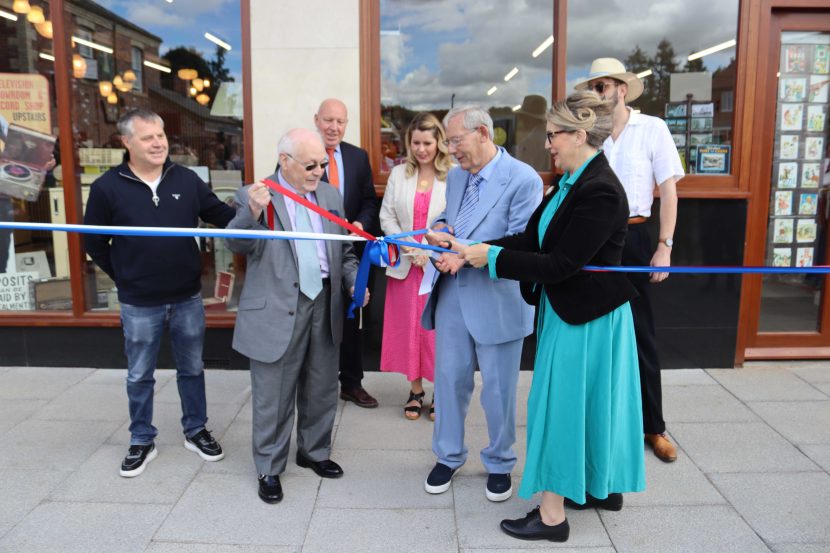A 1950s cinema, toy shop, electrical shop and record store have opened to visitors at Beamish, The Living Museum of the North today (6th July).
The new 1950s Town exhibits include a recreation of the Grand cinema, from Ryhope, in Sunderland; a toy shop named after Romer Parrish in Middlesbrough; A Reece Ltd Radio and Electrical Services electrical and record shop; STEM (science, technology, engineering and maths) learning space and a milk bar.
Communities who were involved in the project took part in the opening celebrations, which included a grand parade, and speakers included North East Mayor Kim McGuinness.
The exhibits in The 1950s Town are the culmination of the Remaking Beamish project, which is the biggest capital development in the County Durham museum’s history. They follow the recent opening of the Georgian Drovers Tavern and pottery, and the museum will also be opening two Georgian-themed self-catering cottages this year, where visitors will be able to stay overnight for the first time.
The Remaking Beamish project is supported by an £11.8million grant from The National Lottery Heritage Fund, with thanks to National Lottery players.
Rhiannon Hiles, Beamish’s Chief Executive, said:
“We’ve had an absolutely fantastic time celebrating the opening of our 1950s cinema, shops and STEM learning space, a huge thank you to everyone who came along to make today so special.
“Today marks an important and exciting moment for the museum, and it means so much to us to hear from visitors how much they love these new 1950s and Georgian additions.
“A heartfelt thank you to everyone involved in the Remaking Beamish project – our staff and volunteers, communities, funders, partners and supporters, including The National Lottery Heritage Fund, Reece Foundation and Friends of Beamish. As a charity, this couldn’t have been achieved without this amazing support.
“The Remaking Beamish project overall has involved over 44,000 community members and school children, more than 22,000 people living with dementia and their families and carers taking part in health and wellbeing activities, and over 35,000 hours have been contributed by volunteers.
“The museum, which welcomed over 800,000 visitors last year, is committed to building on our work with communities and the people of the North East, as an anchor cultural institution in the region, working with partners to help highlight the region as a magnificent place to visit, live and work in.”
North East Mayor Kim McGuinness said:
“Beamish is a huge asset to our region, and not only brings enormous joy to people who visit, it plays a crucial role in our economy, supporting local jobs and attracting 800,000 visitors every year.
“It embodies everything that is great about the North East: steeped in our rich culture and heritage and the great pride we feel about our region, and optimistic about the future. The opening of the wonderful 1950s Town demonstrates the growing strength of our tourism offer.
“As Mayor, I am determined that our great North East is heard on the national and international stage – building on success stories like Beamish to attract more people to discover our amazing part of the world, and create more jobs and opportunity for people living here.”
In addition to The 1950s Town and Georgian developments, The National Lottery Heritage Fund-supported Remaking Beamish project has also included 1950s Spain’s Field Farm and a bus depot.
Beamish has worked closely with communities throughout, with people sharing their memories and stories of 1950s life.
Today, the replicated Grand cinema was opened by Bill Mather, who was a trainee projectionist at the Grand in the 1950s, and Gary Hepple, who donated the cinema to the museum.
Visitors can experience a 1950s trip to the cinema and watch Pathé News, adverts and films. Hundreds of people sponsored cinema seats in support of the project.
Bill, who went on to have a 53-year career managing and owning cinemas, shared his memories of what the Grand was like in the 1950s. He said:
“It has given me an absolute great pleasure to have been able to register my knowledge, from memory, into the foundation and rebuild of what I have termed my ‘Palace of Dreams’..
“Being permitted to voice my love of this wonderful building, so lovingly, recreated at Beamish and having started my ‘over half a century’ in the cinema business at the Grand cinema and seeing the end product is not unlike, to coin a phrase, being the mighty ‘Wizard of Oz’ sitting in my seat, and looking back some almost 10 years working with the Beamish team, and seeing and remembering all those staff from the 50s, who helped make it ‘a night of dreams at the pictures’!
“The icing on the cake is to have been asked to carry out the grand opening of my ‘Palace of Dreams’ and albeit I have opened my own cinemas over the years, this one is special to me as it is where it all started in 1950.”
The Grand was hugely popular in the 1950s, and it later became a bingo hall, before it closed and was donated to the museum by Angela and Gary Hepple. The original building underwent a full architectural survey to assess which materials were suitable for salvage and re-use and a record made of any items that could not be saved. In 2020, the Grand was dismantled, with re-usable parts and features incorporated into the cinema at Beamish.
The toy shop was opened by Brian Parrish, the son of Romer Parrish, after whose popular shop in Middlesbrough the 1950s toy shop is named. Visitors can hear the story of Romer Parrish and his shop, as well as 1950s life in Middlesbrough.
People will be able to see toys from Beamish’s collection and a dolls’ hospital, as well as purchase 1950s-style toys and games.
Brian said:
“In 1933, my father Romer resigned from the family department store in Newcastle to make his own mark in life. He set off walking from Newcastle with his dog, ending up in Middlesbrough where he settled and bought his first shop at 79 Linthorpe Road setting up a Fireside Lending Library, lending books out at sixpence a time. He then expanded into newspapers and cigarettes. While living above the shop he met and married Joan and started a family.
“I would like to thank all the people of Middlesbrough who voted for a toy shop at Beamish and a big thank you to the rest of the North East who shopped with us.
“I would also like to thank all the people at Beamish who made this happen and also a thanks to National Lottery players for making it possible.”
A Reece Ltd Radio and Electrical Services electrical and record shop is named after North East engineer Alan Reece, founder of the Reece Foundation,
In the showroom, visitors can browse the latest 1950s appliances, while in the record shop they can discover popular hits from the day and hear tunes in the listening booths.
In the Reece Workshop STEM learning space, the museum’s Learning Team will use the dedicated facilities to lead activities for schools, inspiring the engineers of the future.
Simon Gilroy, Trustee of The Reece Foundation, said:
“The trustees of the Reece Foundation are immensely proud to see A Reece Ltd Radio and Electrical Services opening as part of the Remaking Beamish project. This initiative is a fitting tribute to Alan Reece, not merely as a name above a shop, but as a dynamic STEM learning space, inspiring future engineers.
“We are confident that young learners and visitors will delight in exploring the 1950s appliances and records, and in participating in activities led by the museum’s Learning Team. The emphasis on enhancing STEM education through this engaging and sustainable development exemplifies our aim to support the long-term prosperity of the North East by promoting engineering, manufacturing, and environmental initiatives.”
The new exhibits also include a milk bar, where visitors can purchase 1950s-style refreshments including flavoured milk and choc ices.
Today’s opening celebrations included a parade, led by Ryhope Allstars Jazz Band and the Ryhope miners’ banner, along with community groups from Ryhope and Middlesbrough, and music and dancers. There was also a display from the Cleveland Miniaturists, as well as work from local schools and community groups in the welfare hall, 1950s vehicles, and a chance to have a go at bowls with Billingham Bowling Club on the bowling green. People could also visit Clover Cottage to discover more about the work of Beamish’s Health and Wellbeing Team.
Ivor Crowther, Head of Investment for England, North at The National Lottery Heritage Fund, said: “It is fantastic to see these elements of the Remaking Beamish project completed as The 1950s Town opens to the public. Made possible thanks to National Lottery players, the Grand cinema, shops, milk bar and new learning space will give visitors the chance to explore the rich and unique heritage of the North East and experience what life would have looked like in the 1950s. We’re incredibly proud to be supporting the ongoing development of Beamish Museum and very excited to join the celebrations this weekend.”
For the new exhibits, Beamish worked with companies including SPACE Architects, BRIMS Construction and Thornton-Firkin, who have strong roots in the North East.
The Remaking Beamish project has been designed with sustainability in mind, with many of the buildings heated by air source heat pumps, more than 1,500 trees and 1,000 metres of hedgerow have been planted, reclaimed stone and paving have been incorporated, water refill stations and reusable cups have been created and electric vehicle charging points have been installed at the self-catering cottages.
Find out more about visiting Beamish Museum at www.beamish.org,uk

